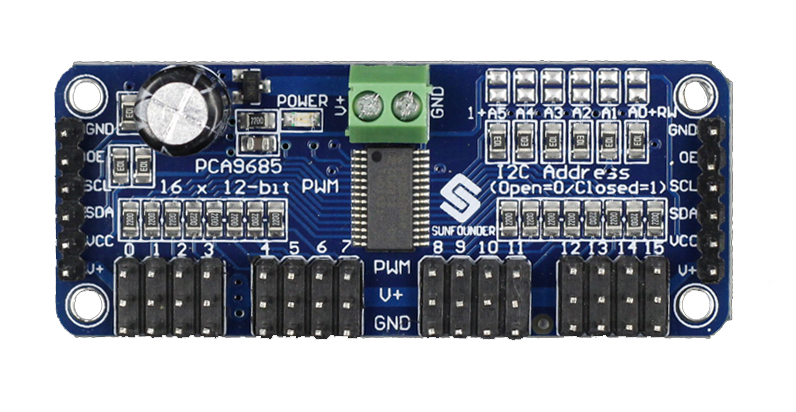PCA9685 16 Channel 12 Bit PWM Servo Driver
Introduction
The PCA9685 is a 16-channel I2C-bus controlled LED controller optimized for Red/Green/Blue/Amber (RGBA) color backlighting applications. Each LED output has individual 12-bit resolution (4096 steps) PWM controller with a fixed frequency. The controller operates at a programmable frequency from a typical 24 Hz to 1526 Hz with a duty cycle that is adjustable from 0% to 100% so the LED can be set to output a specific brightness. All outputs are set to the same PWM frequency.
With the PCA9685 as the master chip, the 16-channel 12-bit PWM Servo Driver only needs 2 pins to control 16 servos, thus greatly reducing the occupant I/Os. Moreover, it can be connected to 62 driver boards at most in a cascade way, which means it will be able to control 992 servos in total.
Feature
1. Contains an I2C-controlled PWM driver with a built-in clock. It means, unlike the TLC5940 family, you do not need to continuously send it signals tying up your microcontroller; it's completely free running!
2. 5V compliant, which means you can control it from a 3.3V microcontroller and still safely drive up to 6V outputs, which is good when you want to control white or blue LEDs with a 3.4V+ forward voltage
3. Supports using only two pins to control 16 free-running PWM outputs – you can even chain up 62 breakouts to control up to 992 PWM outputs.
4. 3 pin connectors in 4 groups, so you can plug in 16 servos at one time (Servo plugs are slightly wider than 0.1" so you can only stack 4 adjacent ones on 0.1"-hole female headers.
5. 12-bit resolution for each output - for servos, that means about 4us resolution at an update rate of 60Hz.
6. Size: 62 x 26 mm
Principle
Based on the above introduction, we can see the module applies the PCA9685 chip as the controller. It can control the output of the 16-channel PWM values. We can manage the PWM frequency and duty cycle to control the servo precisely by programming the controller.
The turn-on time of each LED driver output and the duty cycle of PWM can be controlled independently using the LEDn_ON and LEDn_OFF registers.
If we set the LED_ON time to 409 and LED_OFF time to 1228, the duty cycle of PWM should be:
(1228-409/4096) x 100%= 20%

The servo works like this: The PWM signal captured by the receiving channel is transmitted to the signal demodulation circuit, and a DC offset voltage is generated. Next, this voltage will be compared with the potentiometer’s voltage, and then the voltage drop between them will be input into the motor driving integrated circuit to make the motor rotate clockwise or counter-clockwise. When the rotating speed reaches a certain value, it will drive the potentiometer R0 to spin by the cascaded gear reducer. The motor would not stop rotating until the voltage drop decreases to 0. The servo is controlled by PWM signal, i.e., the changed duty cycle decides where the servo rotates to.
Control a Servo
Controlling a servo rotate from 0°to 180°.
Components
-1 x PCA968 Servo Driver
-1 x Arduino Uno
-1 x Servo
-1 x 18650 Battery Holder
-2 x 18650 Li-on Batteries
-Several jump wires
Step 1. Wiring
Since the servo will use large amount of power, you need to provide this module with an independent power supply so as to ensure the servo will have adequate supply.
Connect the independent power supply to the module as shown below:
| Independent Power Supply | 16-Channel PWM Servo Driver |
| VCC | V+ |
| GND | GND |
Connect the Arduino Uno to the module:
